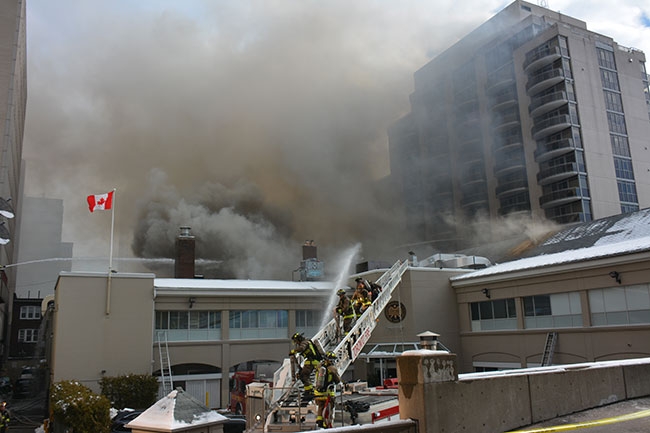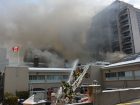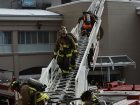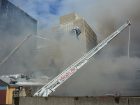
Urban challenge: Fighting a six-alarm fire in the 6ix
Laura King
Features Hot Topics Incident ReportsThe superintendent of Toronto’s Badminton and Racquet Club met Capt. Steve Green in the driveway on Monday, Feb. 14. There was a small fire, the super said, on the second floor, that he had put out with an extinguisher. Nothing to worry about.
 The call at 9:35 a.m. on Feb. 14 indicated a small fire at the Badminton and Racquet Club of Toronto. The raging blaze burned through the night but was contained to the building of origin. In February
The call at 9:35 a.m. on Feb. 14 indicated a small fire at the Badminton and Racquet Club of Toronto. The raging blaze burned through the night but was contained to the building of origin. In FebruaryGreen and his crew from Station 311 were first-in at the massive, six-alarm fire at the private Badminton and Racquet Club.
Capt. Jeff David and his crew from nearby Station 134 also responded to the original alarm.
Deputy Chief Jim Jessop left a senior-management team meeting when the call escalated to a fourth alarm.
Chief Matt Pegg followed, on the fifth alarm.
Fifteen hours later, the fire was contained. Tens of thousands residents, hundreds of thousands of commuters, and myriad businesses were affected.
Pegg says the call constituted the largest deployment of Toronto Fire Services resources – other than the Sunrise Propane fire in 2007 – that anyone on scene had experienced.
Green was heading for the washroom when the call came in at 9:35 a.m.
Station 311 is directly behind the large, L-shaped building that houses courts for tennis, badminton and squash, a formal ballroom, office space, locker rooms, a bar, a store, and fitness facilities.
“The badminton club is in our backyard,” Green said. “It’s a place that we run alarms and first-aid calls; were very familiar with it, but it’s hidden. The driveway goes down off St. Clair West, but no one would even know it exists.
“We got our dispatch and I checked for updates; there weren’t any, but there was a comment saying that it was an unknown fire, so it looked like was it was a fire, not just alarm call.”
Club members had evacuated and were moving their vehicles out of the parking lot.
“One person waving us down,” Green said, “which usually indicates that it’s more than a just false alarm.
“We left the truck on St. Clair because we were unsure if there was a hydrant down by the building.
“We walked down the driveway and met maintenance person and asked him what was going on. He said there was a fire in the second floor, that he had hit it with extinguisher and believed that it was out.
“We didn’t really think that it was anything too concerning. I was thinking that it was something like a garbage can, or stove had caught some cabinets on fire. There was nothing showing. It’s quite a posh club, beautiful inside.
“We went upstairs and there’s quite a large ballroom, which was full of chairs; they were getting ready for a conference.
“[The maintenance guy] brought us around a corner by a hose cabinet through a door that led up to a metal staircase that went up to what looked to be a maintenance room; this room overlooked three tennis courts, so if you can imagine cathedral ceiling, tennis courts inside, and at the peak of a gable over the tennis courts, the metal staircase going up to what I thought was maintenance room.
“There was brown smoke coming out of the door, and that indicated incomplete combustion and that it was more than just a garbage-pail fire.
“I called for a working-fire response, which gives us another three apparatus and a rescue squad; we had a highrise kit and hooked up to hose cabinet.
“By this point another crew had arrived; one hoseline went up the staircase with three crew members, and another hoseline was stretched down the hallway. The initial crew was backing down the stairs, saying this is an extensive fire. We only got a few feet into that door and the thermal alarms on masks started going off; one of the firefighters got burned on the neck. It was at that point I called for second alarm.
“When I had announced a working fire I had asked for a crew to go to the roof, and an aerial crew did so.
“At this point, more crews were arriving; I still believed that it was small room of some sort and that we were going to get a hold of this fire. I had asked for the chairs to be cleared so we could put tarps on the floor and I believed we were going to get a handle on it and knock it down pretty quickly.
“Shortly after that smoke started to filter into the ballroom; I had set up our entry control system; we probably had six firefighters in there plus another two moving chairs out of the way. The smoke was building in the ceiling area and we were using thermal-imaging cameras on the ceiling.
“At the far end of the ballroom I was getting a heat signature and so I said to take down the ceiling. The firefighters said when they took it down there was plywood but they couldn’t access where the fire was. The smoke conditions were getting worse and I asked for one of the windows in the ballroom to be taken out to help ventilate the area. We were starting to lose visibility in the ballroom area and very shortly after that there was a tremendous sound of the ceiling coming down – it was not the drywall, it was the ceiling and the floor and the whole thing came down with a thunderous crush, so much so that we felt the vibrations on the second floor.
“The fire was getting the best of us; we started doing face-to-face PAR making sure everyone was out who was in the hot zone; the fire has broken out and was raging in the ballroom. I sent two firefighters in with thermal cameras to make sure all the firefighters had gotten out; I was very concerned that someone ha been seriously in injured or killed with the ceiling coming down, it was that bad.
“We backed down the stairwell. Some of our hoses had been buried by the collapse and I could tell the fire had been vented through the ceiling because the smoke was drafting into the ballroom area. We tried to fight the fire a little bit more but at that point we knew it was going to an exterior fight.
“The building looks new to me; I did not know that it was an older building. It had obviously gone through may renovations. I suspect that there could have been two ceilings in there. The fire was well seated before we got there and it had escaped room of origin.
“It had probably already escalated to a fourth alarm at this point. We puled our hoses and left some inside that were buried. And then we were assigned different tasks.
“If I can impress upon you anything, it’s the importance of entry control.
“What made this fire difficult was accessing it; the trucks were stationed on Yonge Street with platforms and aerials going over three-storey buildings to get to the fire, and the fire load around it – there were condos literally four feet from the building.
“It’s midtown – there were tens of thousands of people affected; the wind was blowing to the east, into the condo building; office towers had to shut down the ventilation system. Workers were exiting the buildings.
“My biggest takeaway? The maintenance person wasn’t excited so I was surprised that the fire was of some significance; I was thinking that it was just going to be a garbage pail on fire, so you always have to expect the unexpected.
“And the spread of the fire – the fire was not showing; when we showed up there was no smoke visible, so it went from no smoke to a first alarm, to a second to a third to an exterior fight, so the speed at which a fire can burn hidden in a blind spot surprised me. Just because the fire is not showing doesn’t mean there may not be a raging fire in the building.”
Capt. Jeff David and his crew from station 134 were second in, behind pumper 311.
“I met Capt. Green and his crew at the top of the stairs and we were in the ballroom area of the club. Steve and I were talking and an acting captain came down from the area and said something’s going on up here and I think I’ve found it; we started to lay out hoses – there were some problems with standpipe systems – so we laid out hoses and myself and my crew moved into this side room and up the stairs to the doorway leading into that space. My crew and myself made the first attack with a 45 millimetre hand line.
“It was very hot; Darren Pugh, who had the nozzle, was up on the landing and he said when he first got up there was black smoke and it didn’t appear to be all that hot but by the time I got up there and made the attack conditions had deteriorated greatly and the heat pushed us right down to our stomachs.
“In the transition Darren, who had the nozzle, his heat detector went off on his SCBA and was telling him it was very hot. Darren had the 45 millimetre going so I called for another line and quickly changed to 65 millimetre; the other guy with us, Shahram Kouhbad (Shimmy), got the 65 and he started operating it into the room as well, so we were operating a 45 and a 65.
“We didn’t try to get too far into the room; we had both lines operating straight out in front of us and we weren’t hitting anything, so it was a big space we were operating in, and it was just getting hotter and hotter. When I realized with the two lines going we weren’t making any difference we backed out of the room. Darren reported that he felt like he was getting burned so that made the decision pretty easy.
“There was another crew behind us; we wanted to take just a little breather, so we gave the two hoses to them but instructed guys not to enter the room.
“We went back downstairs then went back to help Steve and his crews, pulling ceilings and directing hoselines into the ceiling area.
“We were there until midnight; we got a break around five o’clock and took another truck back to our hall, switched into spare bunker gear, and we were assigned to relieve an aerial crew and spent the next four hours running aerial operations; we got back at midnight and ran calls after that.
“As firefighters we need to be open to the fact that things change so quickly and we need to think on our feet. It was a complex, fast-moving fire and the guys moved along with it, and that’s another reason why everyone went home that night.”
Matt Pegg had already had a busy few days – he had attended a couple of multiple alarm fires, and there had been a fatality. Council was preparing to debate the proposed budget the next day, and all eyes were on him as acting chief.
“This was the most complex and significant deployment of resources at one scene that I’ve seen in Toronto and that I’ve ever witnessed,” Pegg said of the Racquet Club fire.
“The physical size of the structure, the proximity – the building was surrounded by other highrise buildings, which made it an extremely large scene, and it made access extremely difficult. Of course, there was almost immeasurable exposure risk and the fact that you’re talking about the intersection of Yonge and St. Clair – one of busiest in Toronto, and trying to deal with a smoke plume that was variable and unpredictable. The wind was strong and the wind direction was changing frequently.
“At the height of the incident there was about 120 firefighters on the ground. It was one of the largest incident management system deployments that we’ve seen. It was the only incident in my time in Toronto that I’ve seen us set up a second mobile command post.
“The command function is complicated all the time but at an incident that size the incident command process is immense. Simply the task of personnel accountability took multiple people and an immense amount of space. There were multiple people assigned specifically and only to the task of personnel accountability. That took so much effort and so much space we ended up engaging a second command post.
“For such a large, complicated and dangerous scene our incident command team did an amazing job, and that goes all the way to not only the chiefs in the command post but all of the company officers, every firefighter; we had firefighters on the tips of aerials for hours.”
“It wasn’t until you had the aerial view that you could see that it was an inferno,” said Deputy Chief Jim
Jessop.
“We were at our senior-management team meeting. I was the on-call deputy that week; the first notification to management was a second alarm and literally, a minute or so later it went to a third, then a fourth. Once I hit St. Clair I could see nothing but smoke and I knew even blocks away we had a significant challenge.
“I arrived at same time as our senior commanders; we did a quick 360, surveyed what was happening and immediately started to assign responsibility. The commanders – Andy Kostiuk, Len Stadler and Danny MacIsaac – ran operations; I started liaising with Toronto Police because we had to shut down traffic both ways. Toronto Transit Commission streetcars were shut east and west on St Clair. And then I got my first real view of it . . . Matt had already left to respond; basically I told him it appeared to be one of most significant fires I’d seen in a long time. I went to the command post and stated notifying city hall, the mayor’s office, the deputy city manger and the city manager, and made sure that all the appropriate senior staff and elected officials were notified immediately; I could actually see CTV and CP24 helicopters overhead.
“The commanders did a great job positioning aerials in the proper places. Matt took over media duties and asked me to take over liaising with all city agencies. I dealt with the TTC and the next agency we got in touch with was Toronto Water because we needed water pressure boosted with the number of elevated devices flowing; knowing the amount of water we would be flowing, Toronto Hydro and the Electrical Safety Authority were next. We made sure Enbridge Gas was notified. Toronto police sent their command post and a number of senior officers.
“At around noon that day we started formal business cycles. I represented Toronto Fire with commander Danny MacIsaac.
“We instituted the incident command system at the strategic level so we had a unified command.
“At around noon we brought in hazmat trucks because the wind became significant factor with the amount of smoke – we were getting readings inside a number of buildings, especially the condo just south of the fire; we evacuated all the businesses on both sides of St. Clair two blocks south of Yonge, the four corners of Yonge and St. Clair including the CIBC and Scotiabank towers – thousands of people – and the Office of Emergency Management started to make arrangements,.
“This was the first emergency incident where I’ve been on-duty chief for City of Toronto where I personally called the deputy city manger and city manger – it was significant enough that I personally spoke to them and continued to do that throughout the day; that, quite frankly, is something that does not happen, so that gives you the scope of the incident. It is one of the busiest intersections in Canada – you’re looking at transit, business continuity, and the amount of water that was required to stop the fire from spreading was causing water in hydro vaults in underground parking garages that were flooding, so we had crews pumping out water that was the result of the master streams.
“Another thing I have never seen – the commanders made a decision to commandeer a number of balconies at an adjoining condo building. Had that decision not been made, that condo would have suffered significant thermal damage and possibly flame impingement. The Fire Protection and Prevention Act permits us to do that under section 13. That strategic decision saved that adjoining condominium complex – it was so close you could literally step off a balcony onto the roof of the racquet club.
“Our new division chief of investigations, Larry Coco, also respond immediately and was tasked to start looking for the origin and cause. That group started interviewing witnesses, obtaining video feeds, and got onto the balconies to look for the area of origin.
“At around 2 o’clock we were not making headway so the commanders and I did a walk around and were discussing possible strategies because we could not get to the seat of the fire, so we decided that we would exercise our municipal bylaw and bring in heavy equipment to try to get to the seat.
“We had shut down one of the busiest intersections in Canada both ways for blocks, so Toronto Police provided emergency escort for the contractor to pick up the heavy equipment and were able to help the contractors navigate rush hour in downtown Toronto with midtown shut down so we’d have the equipment much sooner.
“We had to remove a number of parked cars and had to arrange for towing of vehicles out of laneway where equipment was going to go.
“Mayor [John] Tory showed up; to put it in perspective, the Tuesday of the fire [Feb. 15] was the first day of debate on the Toronto city budget. Matt was at council all day and I stayed at the fire and was the senior officer on site; I provided Matt with updates on hydro restoration, gas, water, and traffic, and then started working with Toronto building services – building inspectors were on site with engineers and looking at what buildings could not be reoccupied because of potential collapse. All through Tuesday we continued our planning cycle with Toronto Police; our goal Tuesday was to have Yonge and St. Clair open for traffic.
“Tuesday morning we knew we had good control of the fire fire and our unified team’s objective was to have the subway running again and the streetcar tracks cleared. By Tuesday at suppertime we had the streets open, the streetcars running and building inspectors assessing, the investigation running parallel, air monitoring being conducted on all buildings that had been evacuated, and we were working with all property management companies assisting pumping out water.
“By Tuesday evening most of the gas had been repaired and by late in the evening we left two apparatus on scene for a fire watch – we continued to have flare ups for a number of days but at that point traffic was restored, the building department had placed orders restricting occupancy until unstable walls were dealt with, and we were removing historic items from the club, anything we could save.
“By Wednesday noon the command posts were downsized and we transitioned the property back to the owner; all buildings had been reoccupied except 1430 Yonge because it had significant smoke and electrical damage because of the water.
“On the Tuesday I made a point of surveying the damage – apart from the absolutely Herculean efforts of our staff in stopping this fire from spreading, the cost avoidance of the work done by the women and men of Toronto Fire can not be measured – there is between $10 million and $15 million in damage at the club but that pales in comparison to what it would have been had our firefighters not been able to stop the spread.
“It was almost eerie – you walked into the condo units and the coffee was on the tables, the kids’ schoolbags were still at the front door. But our firefighters who went onto the balconies had taken their boots off and laid down paper so they could wipe their feet. We have no reports of any damage to any of the suites we used.
“We used the lessons learned from Elliot Lake and controlled the messaging; we knew our commanders are the best in Canada at tactical issues in downtown cores, so we weren’t worried about that; we had helicopters hovering above us so our number one concern was messaging to the public.
“Every two hours we had a planning meeting. We had senior representatives from each agency with scribes and proper notes. We knew what every agency was doing and what every agency required.
“It was certainly the most complex and challenging fire that I have been at in 21 years. It’s not the largest one Toronto has ever had – Sunrise Propane was the largest – but it was also probably the best organized and most fluid fire operation that literally ran over two days that I have every participated in with other agencies.
That day, the City of Toronto posted the long-vacant fire chief’s job.
Print this page
Advertisement
- Tools of the Trade: Specialized training for specific tasks
- Managing the message: How Toronto’s fire chief uses Twitter to inform


